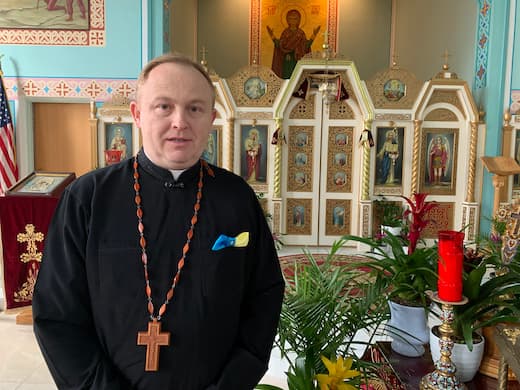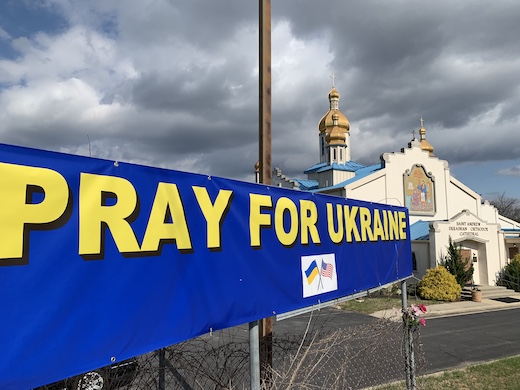Ukrainian Americans Ready To Welcome Refugees of Putin’s War
Some parishioners at St. Andrews are already taking in refugees. Liudmyla Khomemko, 24, recently welcomed her mother-in-law, who was displaced when a bomb destroyed her apartment in Kiev.

Ed Czarnecki is not happy about 100,000 Ukrainian refugees coming to America.
He thinks we can take a lot more.
“Poland has 3 million refugees now,” the Great Falls, Virginia, businessman says. “Moldova has a half a million.” America should allow in “as many as is needed.”
Mr. Czarnecki is attending Divine Liturgy at St. Andrew Ukrainian Orthodox Cathedral just outside of Washington, D.C., where seemingly everyone is ready to open their homes to host refugees from the war.
The 100,000 figure comes from President Biden, who recently announced his administration also plans to spend $1 billion in new funding for humanitarian aid for Ukrainians and refugees in neighboring countries.
“Many Ukrainian refugees will wish to stay in Europe, closer to their homes, but we’ll also welcome 100,000 Ukrainians to the United States with a focus on reuniting families,” Mr. Biden said last week.
Administration officials, who spoke last week on the condition of anonymity under ground rules set by the White House, said they are still working out the details of how the Ukrainians will be admitted, but they could enter America via different legal pathways. These include the U.S. refugee program and “humanitarian parole,” which the Biden administration used for tens of thousands of Afghans last year during Operation Allies Welcome.
Some parishioners at St. Andrews are already taking in refugees. Liudmyla Khomemko, 24, recently welcomed her mother-in-law, who was displaced when a bomb destroyed her apartment in Kiev. Ms. Khomemko displays a picture on her phone of the blasted-out former living space.
Selling custom-made Ukrainian clothing, jewelry, and buttons in the church parking lot is Myoslava Semerey, who was born in Kiev. The 59-year-old lives nearby and says she is ready to help. “We have enough food, we have money. We can take care of them.”
She is waiting for her niece, Natalia, to arrive from Poland, where she fled when the war broke out. Ms. Semery wears a button that expresses an obscenity about Vladimir Putin.
St. Andrews’s head pastor, Father Volodymyr Steliac, notes that while his congregation is prepared to help, there are certain nuts-and-bolts realities that are essential to absorb the newcomers.

“The United States government has decided to welcome 100,000 Ukrainian refugees,” he says. “That is a first stage. That needs to be followed by a plan. The federal government will give to multiple organizations that will be managing that operation. At this point we are not aware of who these organizations are. We have no contact with those organizations. I hope we don’t get 24-hours’ notice, because we will be the ones charged with housing and helping them.”
He continues: “The federal government does not have funds for a lot of things that you might think are not important. It’s a major task to find housing — to find locations, to find the buildings, make sure they are livable. The real estate angle has to be addressed.”
After the Divine Liturgy there follows a community bazaar in the large room adjacent to the chapel. About 100 people talk and eat deruni (potato pancakes), holubtsi, and other dishes from home. Children run around and vendors sell mugs bearing the Ukrainian flag, flowers, jewelry, and various other tchotchkes. Music is played and the kitchen is busy.
During a moment of remembrance for a recently deceased parishioner, a woman takes a microphone and announces that everyone should pray for “a bright future for Ukraine.”

